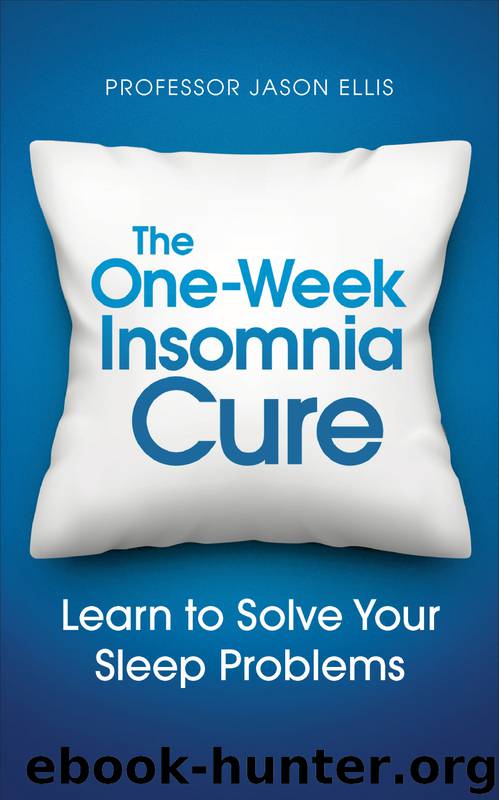The One-week Insomnia Cure by Professor Jason Ellis

Author:Professor Jason Ellis
Language: eng
Format: epub
Publisher: Ebury Publishing
So, now you need to work out your average TST. Remember, I said we were not going to restrict your total sleep time, so your average TST will now become your Prescribed Time in Bed (PTIB) in your personalised sleep plan. In the case of Barry, his PTIB is now 392 minutes.
This is probably the MOST important aspect of sleep rescheduling. Irrespective of what your Sleep Diary calculations suggest, from the data averaged over the week(s), you should NEVER EVER restrict your time in bed (PTIB) to fewer than 5 hours (300 minutes) per night.
So, what should you do if your average over the week is fewer than 5 hours? If your average Total Sleep Time, over the pre-assessment period, works out to be fewer than 5 hours (say, 240 minutes or 270 minutes/4 or 4½ hours) you give yourself a full 5 hours (300 minutes) as your Prescribed Time in Bed. Why? Well, we know that sleeping 4 hours, or fewer, a night can have quite a serious impact on your ability to function properly (your memory, attention, problem solving, reaction time when responding to risk, decision-making ability are all negatively affected) the next day and this amount of sleep can also negatively impact on your immune system’s ability to function and protect you from illness. So, we have to set a benchmark of 5 hours (300 minutes) to be on the safe side.
Right, so now you should have worked out your PTIB, which of course will be 5 hours, or longer. The next thing we need to do is set your bedtime and wake time according to your PTIB. The important thing to do here is ‘anchor’ your PTIB to the morning and keep to that time throughout the course. In other words, think about your week and determine the time you have to be awake by every morning. Most people set this as the time when they need to get up and get ready for work, getting the kids ready for school or getting to college/university. If that is not the case, because either you are retired or not working, you still need to set a time that will work for you.
Set that time as your Prescribed Time Out of Bed (PTOB) first and then work backwards to determine your Prescribed Time to Bed (PTTB). Why do we anchor to the morning? Well, as you will see later, when we further personalise your personal sleep plan, we are likely to be allowing additional Time in Bed (TIB) and you may not be able to add this to the morning as you would already have to be up to start your day (for example, to get ready for work). Alongside that, the other reason we anchor to the morning is we know that keeping to a regular wake-up time is more beneficial for keeping the sleep homeostat and sleep/wake circadian rhythm in concert, compared with your bedtime.
So, how I determine an anchor point is by asking the individual the earliest time they have to be out of bed in the morning in a typical week.
Download
This site does not store any files on its server. We only index and link to content provided by other sites. Please contact the content providers to delete copyright contents if any and email us, we'll remove relevant links or contents immediately.
Name Book, The: Over 10,000 Names--Their Meanings, Origins, and Spiritual Significance by Astoria Dorothy(2836)
Tone Your Tummy Type by Denise Austin(2635)
The Expectant Father by Armin A. Brott & Jennifer Ash(2168)
The Women's Health Fitness Fix by Jen Ator(2133)
The Coregasm Workout by Debby Herbenick(2127)
Expecting Better by Emily Oster(2082)
The Ultimate Guide to Anal Sex for Women by Tristan Taormino(2068)
She-ology by Sherry A. Ross MD(1975)
The Hite Report on Shere Hite by Shere Hite(1957)
Woman: An Intimate Geography by Natalie Angier(1842)
8 Steps to Reverse Your PCOS by Fiona McCulloch(1829)
Birth by Tina Cassidy(1802)
The Female Brain by M.D. Louann Brizendine(1794)
Women & the Weight Loss Tamasha by Diwekar Rujuta(1718)
101 Get-Lean Workouts and Strategies by Muscle & Fitness(1718)
50 Ways to Soothe Yourself Without Food by Susan Albers(1670)
The Big Booty Blueprint: Your Guide To A Bigger Butt In Less Than 12 Weeks by Bella Rahbek & Brandon Carter(1566)
Unleash the Power of the Female Brain: Supercharging Yours for Better Health, Energy, Mood, Focus, and Sex by Daniel G. Amen M.D(1489)
The overachievers by Robbins Alexandra(1487)
